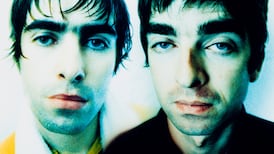Normally, the bread-and-butter programming of Great Music in Irish Houses comes mostly from the core classical repertoire. Last week, the 49th edition of the festival, with its signature offering of chamber music in historic or otherwise interesting venues, included two whole concerts of music by composers either living or not long dead.
One was an all-percussion concert, the second of two events in the one evening. Those who made the physical trek from the first (Chamber Choir Ireland in St Ann's Church, Dawson Street) to the bowels of the glass-and-concrete Printworks building in Dublin Castle for the second, also performed a long, musical leap from Bach to Xenakis and Stockhausen. Colin Currie was the soloist in the former's pulsating and reverberant Rebonds b for an assortment of bongos, bass drum, wood blocks and other percussion, and in Stockhausen's wistful, rather ethereal Vibra-Elufa, adapted for vibraphone from his opera Freitag and challenging, said Currie, the composer's pigeon-holing as "a ferocious modernist".
The concert otherwise featured Currie’s newly formed Colin Currie Quartet, in their Irish debut, in works contrasting different kinds of minimalism. Kevin Volans’s 4 Marimbas offered mesmeric, Philip Glass-style repetition of subtly shifting broken-chord patterns. The evening ended with an illustration of the less oblique processes at work in Steve Reich’s Drumming (Part 1, for pairs of tuned bongos) as the players generated kaleidoscopic shifts of patterns by playing with or slightly against a central, driving tempo.
O’Conor’s honour
The other concert dominated by contemporary music, much of it Irish, was given in Phoenix Park's Farmleigh House by pupils and former pupils of John O'Conor. It was the second of a day-long series of three concerts in the pianist's honour. Most of the Irish pieces were test pieces commissioned by the Dublin International Piano Competition and – as well as offering technical challenges – showed a range of musical responses to non-musical prompts. There was evocative, programmatic music, for example in Elaine Agnew's response to poet Chris Agee's tranquil portrait Seagull – recited by Lance Coburn before he played it – in Soo Jung Ann's account of A Full Moon by David Byers, and in Marian Ingoldsby's lively, rhythmically charged Exchange: The Irish and Normans Mingle at the Fair, a piece from the Ros Tapestry project of the New Ross Piano Festival and performed by its director, Finghin Collins.
Other pieces were more abstract. There was the luxuriant meandering of Reflection II by John Kinsella (also Collins), the gradual calming of rumbling bass figures and flitting arpeggios in Deirdre Gribbin's Unseen played by Sae Yoon Chon, and the heavy, big-boned statements of Gráinne Mulvey's Interference Patterns. This last was played by Alexander Bernstein who then closed the concert with a thrilling, high-octane performance of Frederic Rzewski's pulsing, mechanistic Winnsboro Cotton Mill Blues.
While there was nothing contemporary in the traditional programming of the London Symphony Orchestra under principal guest conductor Gianandrea Noseda in the NCH on Friday, there was an element of weirdness. Ethan Mordden retitled Shostakovich's First Piano Concerto as Concerto for Piano and Orchestra of Strings Only Plus One Crazed Trumpet. This is quite fitting, yet the weirdness on Friday was how trumpet soloist Philip Cobb seemed relatively subdued next to the electrifying and sparkly execution of pianist Daniil Trifonov, who dispatched Shostakovich's thousands of high-energy notes in what might helpfully be described as akin to a crazed manner.
Also slightly weird was the approach to his solo role by viola-player Antoine Tamestit in Berlioz's Harold in Italy. In fact, the piece itself is weird – not quite symphony, not quite viola concerto, not often programmed here, and with the soloist acting as a Byron-Berlioz avatar on a young man's sojourn in Italy. Emphasising this, Tamestit remained off-stage until the viola's first entry, displaying a quasi-persona of traveller in a state of wonder as he eventually, hesitantly, entered from the wing and took his place at the front. He went on to move among the orchestra and play from different locations on stage. (Potentially more disturbing was former principal viola with the Minnesota Orchestra, Thomas Turner, who used to begin on stage and then storm out of an exit door before the end of the first movement.)
But it was good to hear this deeply romantic, often beautiful music sweetly delivered by Tamestit – antics notwithstanding – and lovingly shaped by (the Italian) Noseda with his Rolls Royce instrument.
Lucid miniatures
It was this same kind of shaping that characterised much of the more traditional programming in Great Music in Irish Houses. There were breathtakingly lucid miniatures in pianist Richard Goode's gently intense account of Debussy's second book of Images. Debussy was also among the highlights in the recital by French cellist Marc Coppey and Finghin Collins who gave the Sonata for Cello and Piano – so short but so full and wide-ranging – and the delightful, contrasted etchings of Nadia Boulanger's Trois Pièces. The third of Beethoven's three Rasumovsky string quartets somehow combines richness with economy in a high-voltage first movement, followed by a delicate, Haydnesque minuet before returning to a high-spirited fugal finale – all of this presented with intensity, sure-footed velocity and even a sense of fun by the Pavel Haas Quartet. The clearest, most effective singing by Chamber Choir Ireland – in fine voice and almost always well-blended in St Ann's – came not in the Bach motets where conductor Paul Hillier allowed the busy, sometimes eight-part counterpoint to amass rather than weave, but rather in more chordal moments such as the chorale Es ist genug which demonstrated a gentle expressiveness that the choir also brought to the contemporary piece of the same name by Sven-David Sandström, who died aged 76 on June 10th.










